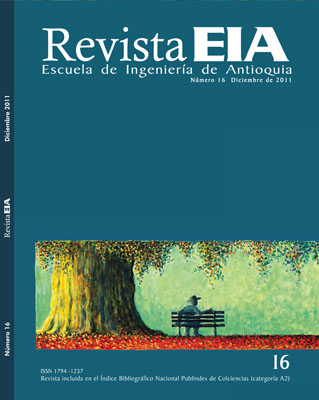PROPIEDADES MECÁNICAS Y COMPORTAMIENTO TRIBOLÓGICO DE RECUBRIMIENTOS MULTICAPA DE CrN/TiN (MECHANICAL PROPERTIES AND TRIBOLOGICAL BEHAVIOUR OF CrN/TiN MULTILAYER COATINGS)
PROPIEDADES MECÁNICAS Y COMPORTAMIENTO TRIBOLÓGICO DE RECUBRIMIENTOS MULTICAPA DE CrN/TiN (MECHANICAL PROPERTIES AND TRIBOLOGICAL BEHAVIOUR OF CrN/TiN MULTILAYER COATINGS)


This work is licensed under a Creative Commons Attribution-NonCommercial-NoDerivatives 4.0 International License.
Copyright statement
The authors exclusively assign to the Universidad EIA, with the power to assign to third parties, all the exploitation rights that derive from the works that are accepted for publication in the Revista EIA, as well as in any product derived from it and, in in particular, those of reproduction, distribution, public communication (including interactive making available) and transformation (including adaptation, modification and, where appropriate, translation), for all types of exploitation (by way of example and not limitation : in paper, electronic, online, computer or audiovisual format, as well as in any other format, even for promotional or advertising purposes and / or for the production of derivative products), for a worldwide territorial scope and for the entire duration of the rights provided for in the current published text of the Intellectual Property Law. This assignment will be made by the authors without the right to any type of remuneration or compensation.
Consequently, the author may not publish or disseminate the works that are selected for publication in the Revista EIA, neither totally nor partially, nor authorize their publication to third parties, without the prior express authorization, requested and granted in writing, from the Univeridad EIA.
Show authors biography
Los recubrimientos multicapa representan una clase promisoria de recubrimientos protectores, gracias a la
mejora en las propiedades tribológicas, mecánicas y anticorrosivas que confieren a las superficies recubiertas. Esto ha motivado la investigación, desarrollo e implementación de estos materiales en muchas aplicaciones industriales, debido a que en la actualidad los requisitos que se tienen en la industria no se satisfacen con materiales que cumplan con una propiedad buena, sino con una combinación de buenas propiedades para la mayoría de las aplicaciones. En este trabajo se depositaron recubrimientos multicapa de CrN/TiN por pulverización catódica; la variación del número de bicapas de los recubrimientos con 4 µm de espesor fue de 10, 40, 80 y 100. El tamaño de grano y la rugosidad de los recubrimientos se determinaron mediante microscopía de fuerza atómica; se realizaron pruebas de microdureza y adhesión por rayado, los coeficientes de fricción se evaluaron en un tribómetro de tipo esfera sobre disco y la resistencia al desgaste abrasivo se determinó por el método Calotest. Los recubrimientos con 100 bicapas de CrN/TiN exhibieron un volumen de desgaste dos órdenes de magnitud menor que las muestras de una monocapa de TiN y de CrN. Las propiedades mecánicas fueron fuertemente influenciadas con la disminución del espesor del período de modulación de los recubrimientos, incrementándose de 23,1 GPa para la muestra con 10 bicapas a 29,8 GPa para la muestra con 100 bicapas de CrN/TiN.
Abstract: Multilayer coatings represent a promising class of protective coatings due to the improvement in tribological, mechanical, and anticorrosive properties conferred to the coated surfaces. This has motivated the research, development and implementation of these materials in many industrial applications; nowadays the requirements of the industry are not satisfied with materials that have a good property, but a combination of good properties for most of the applications. In this work CrN/TiN multilayer coatings were deposited by magnetron sputtering; the variation of number of coating bilayers with 4 µm total thickness was of 10, 40, 80 and 100. The grain size and the roughness of coatings were determined by means of atomic force microscopy; micro hardness and scratch adhesion tests were performed, the friction coefficients were evaluated in a ball on disk tribometer, and the abrasive wear resistance was determined by Calotest method. The coatings with CrN/TiN 100 bilayers exhibited a wear volume two orders of magnitude lower than the single layer coatings of TiN and CrN. Mechanical properties were strongly influenced by the decrease of the modulation period thickness of the coatings, having increased from 23.1 GPa for the sample with 10 bilayers to 29.8 GPa for the sample with CrN / TiN 100 bilayers.
Article visits 245 | PDF visits 173
